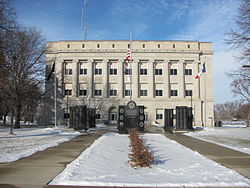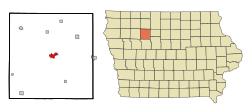Pocahontas, Iowa
City in Iowa, United States From Wikipedia, the free encyclopedia
City in Iowa, United States From Wikipedia, the free encyclopedia
Pocahontas is a city in and the county seat of Pocahontas County, Iowa, United States.[3] The population was 1,867 in the 2020 census, a decline from the 1,970 population in 2000.[4]
Pocahontas, Iowa | |
|---|---|
 | |
| Nickname: The Princess City | |
 Location of Pocahontas, Iowa | |
| Coordinates: 42°44′4″N 94°40′23″W | |
| Country | |
| State | |
| County | Pocahontas |
| Incorporated | May 16, 1892 [1] |
| Government | |
| • Mayor | Dick Gruber |
| Area | |
| • Total | 1.98 sq mi (5.12 km2) |
| • Land | 1.98 sq mi (5.12 km2) |
| • Water | 0.00 sq mi (0.00 km2) |
| Elevation | 1,220 ft (372 m) |
| Population (2020) | |
| • Total | 1,867 |
| • Density | 944.84/sq mi (364.81/km2) |
| Time zone | UTC-6 (Central (CST)) |
| • Summer (DST) | UTC-5 (CDT) |
| ZIP code | 50574 |
| Area code | 712 |
| FIPS code | 19-63975 |
| GNIS feature ID | 0460342 |
| Website | www |
Pocahontas was first settled and surveyed in 1870 by Warrick and Buelah Price of Cleveland, Ohio.[5] The city was named after Pocahontas, a Powhatan woman from Jamestown, Virginia. Other geographical names in the county related to the colony at Jamestown are Rolfe, Powhatan Township and Varina.[6]
Pocahontas was incorporated as a city on May 16, 1892.[1]
During the tornado outbreak of April 9–11, 2011, several tornadoes hit Pocahontas County and the surrounding area. No one was injured and there were no fatalities. The strongest was an EF4 that touched down west of town.
Pocahontas's longitude and latitude coordinates in decimal form are 42.734476, -94.673017.[7]
According to the United States Census Bureau, the city has a total area of 2.02 square miles (5.23 km2), all land.[8]
Pocahontas lies at the northwestern margin (rim) of Manson crater, an impact structure buried by glacial till and outwash.[9]
According to the Köppen Climate Classification system, Pocahontas has a hot-summer humid continental climate, abbreviated "Dfa" on climate maps.
| Climate data for Pocahontas, Iowa, 1991–2020 normals, extremes 1904–present | |||||||||||||
|---|---|---|---|---|---|---|---|---|---|---|---|---|---|
| Month | Jan | Feb | Mar | Apr | May | Jun | Jul | Aug | Sep | Oct | Nov | Dec | Year |
| Record high °F (°C) | 68 (20) |
67 (19) |
87 (31) |
98 (37) |
107 (42) |
106 (41) |
110 (43) |
111 (44) |
101 (38) |
94 (34) |
81 (27) |
68 (20) |
111 (44) |
| Mean maximum °F (°C) | 44.4 (6.9) |
51.3 (10.7) |
69.9 (21.1) |
82.7 (28.2) |
90.6 (32.6) |
94.3 (34.6) |
93.4 (34.1) |
91.5 (33.1) |
89.7 (32.1) |
84.6 (29.2) |
67.7 (19.8) |
51.2 (10.7) |
95.9 (35.5) |
| Mean daily maximum °F (°C) | 25.6 (−3.6) |
30.1 (−1.1) |
43.6 (6.4) |
58.8 (14.9) |
70.9 (21.6) |
81.4 (27.4) |
84.4 (29.1) |
81.8 (27.7) |
76.1 (24.5) |
62.3 (16.8) |
45.0 (7.2) |
31.2 (−0.4) |
57.6 (14.2) |
| Daily mean °F (°C) | 16.6 (−8.6) |
20.9 (−6.2) |
33.8 (1.0) |
47.2 (8.4) |
59.7 (15.4) |
70.4 (21.3) |
73.4 (23.0) |
70.6 (21.4) |
63.2 (17.3) |
49.9 (9.9) |
34.9 (1.6) |
22.4 (−5.3) |
46.9 (8.3) |
| Mean daily minimum °F (°C) | 7.5 (−13.6) |
11.7 (−11.3) |
24.0 (−4.4) |
35.5 (1.9) |
48.5 (9.2) |
59.3 (15.2) |
62.3 (16.8) |
59.5 (15.3) |
50.4 (10.2) |
37.5 (3.1) |
24.7 (−4.1) |
13.6 (−10.2) |
36.2 (2.3) |
| Mean minimum °F (°C) | −14.4 (−25.8) |
−9.6 (−23.1) |
2.2 (−16.6) |
21.3 (−5.9) |
34.4 (1.3) |
46.7 (8.2) |
51.8 (11.0) |
49.0 (9.4) |
34.5 (1.4) |
21.1 (−6.1) |
6.9 (−13.9) |
−8.8 (−22.7) |
−18.3 (−27.9) |
| Record low °F (°C) | −36 (−38) |
−30 (−34) |
−25 (−32) |
2 (−17) |
22 (−6) |
32 (0) |
41 (5) |
35 (2) |
21 (−6) |
−2 (−19) |
−13 (−25) |
−29 (−34) |
−36 (−38) |
| Average precipitation inches (mm) | 1.02 (26) |
1.02 (26) |
2.04 (52) |
3.41 (87) |
4.57 (116) |
4.67 (119) |
4.02 (102) |
4.34 (110) |
2.60 (66) |
2.28 (58) |
1.60 (41) |
1.22 (31) |
32.79 (834) |
| Average snowfall inches (cm) | 9.3 (24) |
7.4 (19) |
5.8 (15) |
1.9 (4.8) |
0.0 (0.0) |
0.0 (0.0) |
0.0 (0.0) |
0.0 (0.0) |
0.0 (0.0) |
0.4 (1.0) |
3.7 (9.4) |
10.3 (26) |
38.8 (99.2) |
| Average precipitation days (≥ 0.01 in) | 7.0 | 6.5 | 8.3 | 9.9 | 13.0 | 11.3 | 9.0 | 8.9 | 8.5 | 8.1 | 5.9 | 6.9 | 103.3 |
| Average snowy days (≥ 0.1 in) | 5.1 | 4.9 | 2.8 | 1.1 | 0.0 | 0.0 | 0.0 | 0.0 | 0.0 | 0.3 | 2.3 | 5.0 | 21.5 |
| Source 1: NOAA[10] | |||||||||||||
| Source 2: National Weather Service[11] | |||||||||||||
As of the census of 2020,[13] there were 1,867 people, 846 households, and 492 families residing in the city. The population density was 944.8 inhabitants per square mile (364.8/km2). There were 954 housing units at an average density of 482.8 per square mile (186.4/km2). The racial makeup of the city was 95.9% White, 0.7% Black or African American, 0.2% Native American, 0.3% Asian, 0.0% Pacific Islander, 0.4% from other races and 2.6% from two or more races. Hispanic or Latino persons of any race comprised 0.7% of the population.
Of the 846 households, 22.8% of which had children under the age of 18 living with them, 45.9% were married couples living together, 5.0% were cohabitating couples, 29.8% had a female householder with no spouse or partner present and 19.4% had a male householder with no spouse or partner present. 41.8% of all households were non-families. 37.7% of all households were made up of individuals, 20.8% had someone living alone who was 65 years old or older.
The median age in the city was 46.9 years. 23.9% of the residents were under the age of 20; 3.8% were between the ages of 20 and 24; 20.9% were from 25 and 44; 23.7% were from 45 and 64; and 27.7% were 65 years of age or older. The gender makeup of the city was 47.2% male and 52.8% female.
As of the census[14] of 2010, there were 1,789 people, 852 households, and 493 families residing in the city. The population density was 885.6 inhabitants per square mile (341.9/km2). There were 953 housing units at an average density of 471.8 per square mile (182.2/km2). The racial makeup of the city was 98.3% White, 0.3% African American, 0.1% Native American, 0.1% Asian, 0.1% Pacific Islander, 0.1% from other races, and 1.0% from two or more races. Hispanic or Latino of any race were 1.3% of the population.
There were 852 households, of which 21.6% had children under the age of 18 living with them, 48.0% were married couples living together, 7.2% had a female householder with no husband present, 2.7% had a male householder with no wife present, and 42.1% were non-families. 39.1% of all households were made up of individuals, and 22.4% had someone living alone who was 65 years of age or older. The average household size was 2.04 and the average family size was 2.70.
The median age in the city was 51.1 years. 19.2% of residents were under the age of 18; 5.5% were between the ages of 18 and 24; 16.6% were from 25 to 44; 29.5% were from 45 to 64; and 29.2% were 65 years of age or older. The gender makeup of the city was 46.6% male and 53.4% female.
As of the census[15] of 2000, there were 1,970 people, 883 households, and 549 families residing in the city. The population density was 1,059.8 inhabitants per square mile (409.2/km2). There were 946 housing units at an average density of 508.9 per square mile (196.5/km2). The racial makeup of the city was 98.68% White, 0.25% African American, 0.15% Native American, 0.10% Asian, 0.20% from other races, and 0.61% from two or more races. Hispanic or Latino of any race were 0.51% of the population.
There were 883 households, out of which 25.8% had children under the age of 18 living with them, 53.3% were married couples living together, 7.1% had a female householder with no husband present, and 37.8% were non-families. 36.1% of all households were made up of individuals, and 24.0% had someone living alone who was 65 years of age or older. The average household size was 2.16 and the average family size was 2.79.
Age spread: 23.1% under the age of 18, 4.8% from 18 to 24, 22.1% from 25 to 44, 25.3% from 45 to 64, and 24.7% who were 65 years of age or older. The median age was 45 years. For every 100 females, there were 84.6 males. For every 100 females age 18 and over, there were 79.1 males.
The median income for a household in the city was $30,865, and the median income for a family was $42,690. Males had a median income of $29,806 versus $19,886 for females. The per capita income for the city was $17,556. About 6.7% of families and 9.1% of the population were below the poverty line, including 12.9% of those under age 18 and 5.9% of those age 65 or over.
In 1900, a railroad came to Pocahontas.[5] Air transportation for the town is provided by Pocahontas Municipal Airport (FAA Identifier KPOH), located approximately one mile northeast of the city. The airport has two runways, the first is designated 11/29, with a concrete surface 4100 x 60 ft (1250 x 18 m) and runway edge lights, the second is designated 18/36 with a turf surface 1998 x 135 ft (609 x 41 m) and is unlighted.[16]
Pocahontas Area Community School District operates public schools.[17]
Seamless Wikipedia browsing. On steroids.
Every time you click a link to Wikipedia, Wiktionary or Wikiquote in your browser's search results, it will show the modern Wikiwand interface.
Wikiwand extension is a five stars, simple, with minimum permission required to keep your browsing private, safe and transparent.